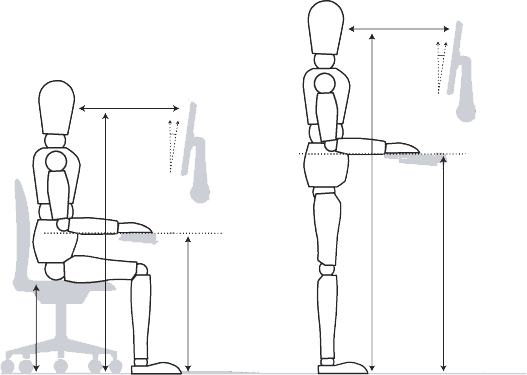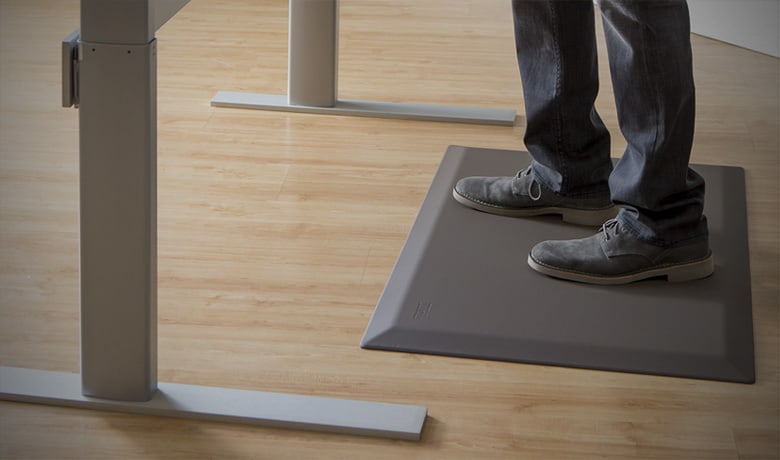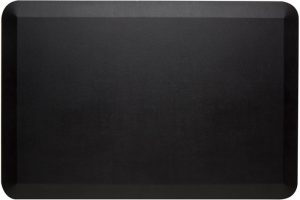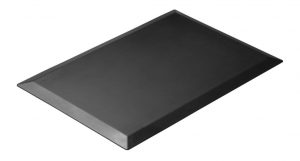An anti-fatigue mat helps alleviate back pain, muscle stiffness and leg pain associated with standing for long periods of time. These handy mats can be seen in factories, office spaces, kitchens, and other places where standing for long periods of time is a normal part of the job. Home consumers can also use anti-fatigue mats for the kitchen, shop or garage where standing for several hours might come into play. If you're interested in keeping back-pains at bay and maintaining a body with good posture (as you probably are if you're reading this), then a standing desk in your home office is also a great option. In fact, most of the desks we supply to home consumers are used for home offices. Note: we don't recommend spending long periods on your feet. The beauty of height-adjustable desks is that you can move between standing and sitting positions easily. Periods of standing should be broken up with periods of sitting.
Here’s everything you need to know about floor mats for use with a sit stand desk, why they are important, and the proper way to use one.
Comfort while standing
 An anti fatigue floor mat helps maintain your physical comfort while standing. It’s generally thought of as a mat to purely prevent back pain, but these mats can also prevent health concerns in the feet, legs, shoulders, and neck. How you stand up is as important as what you stand upon. When using a standing desk, your head, neck, torso and legs should remain in one vertical line. That means keeping your back straight.
An anti fatigue floor mat helps maintain your physical comfort while standing. It’s generally thought of as a mat to purely prevent back pain, but these mats can also prevent health concerns in the feet, legs, shoulders, and neck. How you stand up is as important as what you stand upon. When using a standing desk, your head, neck, torso and legs should remain in one vertical line. That means keeping your back straight.
The desk should be at a height where your arms and wrists naturally come straight out from your body. You shouldn’t have to use books, boards or notepads to change the height of your workstation. The keyboard and mouse are at the same level surface, and the top of the monitor should be at the level of your eyes. Keep your upper arms close to your sides. Your wrists should stay straight, and your hands remain at or below elbow level.
Adjustable standing desks are ideal for your posture when you stand at the office because they move to your precise height requirements. Of course, you can also make your standing desk more comfortable with an anti-fatigue mat.
How to use an Anti-Fatigue mat

Imprint Comfort Mats CumulusPRO Anti-Fatigue Mat
Place the center of your anti-fatigue mat where you intend to stand the longest. This may put part of the mat underneath a standing desk, but some of it may spill over into a walkway. Workers should use caution around ant kind of synthetic floor mat so they don’t trip over the mat. If your workspace is enclosed, try to keep the mat in the center of everything.
You should wear soft-soled shoes with proper arch and heel support. Avoid standing on anti-fatigue mats in your socks or barefoot. You might slip if you wear socks, and bare feet should never happen in a working environment due to several safety concerns.
Even though polyurethane mats, great shoes and an ergonomic workstation can prevent aches and pains from standing, studies show you can’t just stand there for hours at a time. To prevent discomfort, flex and stretch your muscles. Walk around the office for a few minutes. Take a break after 90 minutes and sit down for five to 30 minutes. In fact, we prefer to sit for 30 mins and stand for 30 mins, throughout the day.
Types of Anti-Fatigue Mats
The most basic anti-fatigue mats are made of carpet or foam. These are great for household use where you may not stand for many hours at a time. Gel-filled mats are also practical choices for the home, and these types of mats may have anti-slip coverings.
 Heavy rubber floor mats or foam (polyurethane) mats are the best ones to have at work or the home-office. These heavy-duty mats can handle a lot of wear and tear. Denser foam is preferred because your legs and feet don’t have to expend a lot of energy to make basic movements. Rubber floor mats for industrial uses come in rolls, standard sizes or in interlocking pieces if you have a large workspace.
Heavy rubber floor mats or foam (polyurethane) mats are the best ones to have at work or the home-office. These heavy-duty mats can handle a lot of wear and tear. Denser foam is preferred because your legs and feet don’t have to expend a lot of energy to make basic movements. Rubber floor mats for industrial uses come in rolls, standard sizes or in interlocking pieces if you have a large workspace.
Mats that come in large sizes generally stay put and don’t move. However, you can buy smaller foam mats that workers can scoot underneath a workstation when they aren’t in use. Some of the best smaller mats allow you to move them when you’re not standing on them, but when you add weight the mats stay in place without slipping.
Look for high-performance or heavy-duty mats for the workplace. These stand up to constant use better than ones that are made of lesser materials.
The type of anti-fatigue mat you use is an important factor at the office when you take into account high volumes of traffic, the number of standing workstations and space considerations. Thickness of floor mats becomes an issue when you try to maximise the comfort of workers.
Thickness of Comfort Mats
 Thicker isn’t necessarily better when it comes to standing desk mats. Thick foam might be too cushiony, and employees might have to move their legs up and down unnecessarily just to perform basic movements. Thick, soft mats may actually make fatigue even worse.
Thicker isn’t necessarily better when it comes to standing desk mats. Thick foam might be too cushiony, and employees might have to move their legs up and down unnecessarily just to perform basic movements. Thick, soft mats may actually make fatigue even worse.
One key consideration when you purchase an anti-fatigue mat is the flooring underneath it. If you have carpeting or a wood floor, buy a mat that isn’t as thick. If your floor is hard concrete, definitely go for the sturdy foam rubber variety. You can still purchase a good foam mat without having one that gets in the way of basic movements.
Most mats are one inch or less in thickness in the areas where you stand. Some polyurethane mats have raised portions on the edges so you can grip them easier when you move them. Mats that are thicker around the edges tend to last longer because they are less susceptible to nicks and dings that might take chunks out of the mat itself.
The best anti-fatigue mats you can buy come with five-year warranties, or even better, 10-year warranties, as with the CumulusPRO. Those are the ones that deserve your investment because companies back five to 10-year warranties with high-quality craftsmanship and durable materials.
Once you buy a cushioned mats for standing, you need to know how to take care of it so it lasts a long time.
Caring and Cleaning Your Anti-Fatigue Comfort Mat
One important thing to remember is that these floor mats are not necessarily designed to prevent slips and falls. These are not anti-slip mats. If you spill water on them, clean up the mess as soon as possible. If you work in a wet environment, consider putting an anti-fatigue mat on top of an anti-slip mat, but only if that doesn’t cause problems.
Regular cleaning and care depend on the materials of your mat. Mats with a carpet-like material on top should be vacuumed at least once per week. Rubber mats that get grease, oil or other liquids on them should be mopped with a damp cloth, sponge or mop daily and then dried completely. Anti-fatigue mats that get wet should be dried as soon as possible.
Dust can accumulate on floor mats, and even a thin layer may make these objects slippery. Polyurethane mats such as the Cumulus Pro should be dusted with a dry cloth daily, if not, weekly, to prevent slips and falls. This way, you get the most benefits out of your investment.
Benefits of a Standing Desk Floor Mat
Studies show that standing desk mats, combined with proper shoes and posture, significantly reduce aches, pains, sore muscles and tired legs when working at a desk. When your muscles aren’t achy, it saves energy and makes you feel more refreshed by the end of the day. Over the long term, a floor mat can help prevent mobility problems while increasing productivity and decreasing time off for sick days.
In 2013, more than 131 million working days were lost in the United Kingdom due to sick days. Of those days, 24 percent (31 million) were due to back and neck pain. Standing for 90 minutes or more can cause circulatory problems over the long term so just as sitting is dangerous, standing should also be considered risky if performed for extra long periods of time.
The benefits of a floor mat for your standing desk are win-win when used properly.
Conclusion
Anti-fatigue mats may not solve everything at the office when it comes to tired legs, sore muscles and aching feet in employees. However, these accessories are a step in the right direction when you use standing desks and workstations. Remember to examine the workmanship of a mat, the overall price and the length of the warranty. Purchase a standing desk floor mat based on the type of material of your floor. Harder floors need thicker mats, but don’t get mats that are too thick because employees might stumble over them and fall. Take your time and make the correct purchase. Investing in anti-fatigue mats can be a worthwhile endeavour for you and your employees. Therefore, you should make the right purchase the first time.
Try the CumulusPRO Comfort Mat, voted the best standing desk mat by Forbes Magazine.
